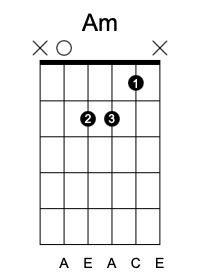The Am7 guitar chord is the symbol for A minor with flat 7th. We show how to use the Am7 in several contexts, to understand how to apply it to any key.
First, it is important to notice that this is a four note chord, or tetrad, with is formed from the harmonic field of the A minor scale or C major.
On one hand, this chord can be part of the A minor key, where this chord if the first one in the harmonic field.
But frequently this is also used in the In the C major key, this is the 6th chord, the relative minor of C.
In this page, you’ll find basic information about the Am7 chord, but also some more advanced techniques to take advantage of this guitar chord in your songs.
The Basic Am Chord
 Before we deal with the Am7 chord, let’s recap the basic Am guitar chord. The Am chord is a triad, that is, it has only three notes: A, C, and E. These three notes are separated by thirds, and the first third interval is a minor interval: therefore, this is a minor chord.
Before we deal with the Am7 chord, let’s recap the basic Am guitar chord. The Am chord is a triad, that is, it has only three notes: A, C, and E. These three notes are separated by thirds, and the first third interval is a minor interval: therefore, this is a minor chord.
To build the Am chord in the guitar, we need to find configurations for the triad A, C, E in the fretboard. Here are some common possibilities used by guitar players:

Am Chord
How to Play Am7 on Guitar
Apart from the basic position, there are many options that you can use to play this Am7 chord. Another common possibility for this chord is building the root on the 5th fret:

Am Chord 5th fret
Am7 Guitar Chord: Easy Way
If you’re just starting playing the guitar, you may look for some easy ways to play the same chord. There are plenty of other ways to play this chord in a way that may easier for your.
And here is still another easy way to play this chord, this time starting on the 4th string, 7th fret. The advantage of this method is that you don’t need to use a bar chord:

Also Read:
Guitar String Notes: Easily Finding Them
Find Here the Best, Cheap 12 String Electric Guitars
Best Fender Acoustic Guitar Models
Positions for the Am7 Chord
 Now we get the Am7. Unlike the Am chord, the Am7 chord is a tetrad, it has four notes. The first three notes are the same, A, C, E, and the last note is G, the 7th of A.
Now we get the Am7. Unlike the Am chord, the Am7 chord is a tetrad, it has four notes. The first three notes are the same, A, C, E, and the last note is G, the 7th of A.
The Am7 guitar chord can have several formations, depending on the desired position on the guitar neck.
The most common position is the open position with root on the 5th string:
Another common position for this chord is with the key note in the sixth string, 5th fret:
Still another position for the Am7 chord starts on the 4th string:

Am7 Guitar Chord: Easy Way to Play
Another easy way to play the Am7 chord is to exploit the open 5th string to simplify the finger position.
A common way to create new chords in the guitar is to use one or more open strings. This way, you can get a useful sound without bending your fingers…
Here is an example with the Am7 chord:

You need to use the open 5th string, and a single bar to hold the other strings in the 5th fret.
Am7 Chord as a Tetrad
 Unlike the Am chord, which is a triad (that is, it has only three notes), the Am7 chord is a tetrad. This means that it has four notes, instead of three.
Unlike the Am chord, which is a triad (that is, it has only three notes), the Am7 chord is a tetrad. This means that it has four notes, instead of three.
Tetrads are used to create more colorful versions of the basic chords. And you create a tetrad chord by adding the third after the 5th, which is the seventh.
The Am7 chord contains, therefore, a tetrad that contains the three basic notes A-C-E, which are the fundamental, third, and fifth. But it also contains the 7th, which in this case is G.
Uses of the Am7 Chord
The Am7 chord is very versatile, and can be used in several situations. You should learn to use the Am7 in several contexts, to understand the way it can be applied in different keys.
For example, in the C major key, the Am7 is a 6th chord. This can be used, for example, in the 1-6-2-5 chord sequence. Several songs use this type of movement.
In the E minor key, the Am7 is a 4th chord.
On the other hand, in the G major key, the Am7 is a 2nd chord of the harmonic sequence.
Moreover, in the F major key, the Am7 may appear as a 3rd chord.
In the A minor chord, the Am7 is a root chord.
Finding the Harmonic Context for Am7
As you see, the use of this chord will change depending on the harmonic context. To analyze the correct harmonic context of Am7 you need to do the following:
- Determine the tonic of the song you’re playing.
- Determine if there was any change in the tonality inside the song.
- Based on this, measure the interval between the tonic and the chord Am7 that you’re playing.
- With this information, you can determine if you’re plain a forth, second, or other interval.
Also notice that the Am7 chord can only appear where a minor chord is usable. For example, if the harmony is asking for a dominant chord, then you cannot use the Am7.
Famous Songs Containing the Am7 Chord
Here is a quick list of famous songs that contain the Am7 chord:
I Guess That’s Why They Call It The Blues: Elton John
Variations of the Am7 chord
This chord has several variations, forming a family of chords, including the following:
Am7/9: This chord includes the minor seventh and ninth. It is a slightly dissonant chord that can be used in many songs and variations.

Am7/5b: This minor chord is used as the 2 in the 2-5-1 sequence, when the 1 is the G minor chord.

How to Practice the Am7 Chord?
Practicing the Am7 chord is essential for developing your fretting hand technique and getting comfortable with the shape and sound of the chord. Here’s a step-by-step guide on how to practice the Am7 chord effectively:
- Learn the Finger Placement: Place your index finger (1st finger) on the 1st fret of the B string (second thinnest string). Place your middle finger (2nd finger) on the 2nd fret of the D string (fourth thinnest string). Leave the other strings open and let them ring.
- Check for Clean and Clear Sound: Strum all the strings with your picking hand to ensure that each note sounds clean and clear. Adjust your finger placement and pressure if any notes sound muted or buzzing. Aim for a consistent and full sound from each string.
- Practice Fretting Hand Position: Pay attention to the position of your fretting hand. Keep your fingers curved and close to the fretboard to minimize unnecessary string buzzing and ensure proper finger placement. Work on developing a relaxed yet firm grip on the strings.
- Strumming and Fingerpicking Practice: Once you’re comfortable with the finger placement, practice strumming the Am7 chord using different strumming patterns. Start with a simple downstroke strumming pattern and gradually progress to more complex patterns. Ensure that all the strings ring out clearly and that your strumming hand remains relaxed.
If you prefer fingerpicking, practice plucking the individual strings of the Am7 chord in different patterns. Start with plucking the strings sequentially from the lowest-pitched to the highest-pitched string (e.g., A, D, G, B, E). Then experiment with other fingerpicking patterns, such as arpeggios or alternating bass notes.
- Chord Transitions: Practice transitioning smoothly between the Am7 chord and other chords. Choose a few common chords like C, G, F, or Dm and practice switching between them and the Am7 chord. Focus on maintaining a steady rhythm and accuracy in your chord changes.
- Repetition and Variation: Repeat the chord exercises regularly to build muscle memory and familiarity with the Am7 chord. Gradually increase the tempo as you become more comfortable and accurate. Additionally, experiment with different voicings of the Am7 chord on different areas of the fretboard to expand your chord vocabulary.
- Apply the Chord in Songs: Look for songs that use the Am7 chord and practice playing along. This will help you understand how the chord is used in a musical context and improve your overall playing skills.
The Am/G and Am7/G Guitar Chord
This is yet another variation of the Am chord. It is used frequently when moving from Am7 to F. This way, you can use Am7/G as a middle step between these two chords.
Am7/G: This form of the A minor 7th chord. Guitar players frequently use it when the moving bass is going down, so it works well as a passage chord.

Different Ways to Notate The Am7 Chord
 Chord notation differs from place to place, since it is not standard. Unlike traditional music notation, chord notation will change depend on where you are, or the style you’re playing.
Chord notation differs from place to place, since it is not standard. Unlike traditional music notation, chord notation will change depend on where you are, or the style you’re playing.
That’s why there are different ways to represent the Am7 chord. It can be notated as:
- Am7: the most common way in north America.
- A-7: another notation, where the minus sign is used to denote the minor chord.
- Amin7: this version is used in a few song books, to make it clear that you’re referring to a minor chord.
- The number 7 can also be placed above the chord symbol, as a superscript.
- a7: In classical music notation, it is sometimes used the lower case a as representing the minor chord (the major chord with seventh would be A7).
All these ways are valid notations for the same chord. So, you may find this in the songs you’re reading.
Where the Use the Am7 Chord
 The important questions that needs to be answered is where is the best way to use this chord.
The important questions that needs to be answered is where is the best way to use this chord.
The simple version is that the Am7 chord can be used in practically any place that the Am chord is also used.
The reason is that the 7th note in this chord is compatible with practically any situation where the Am triad works. There are very few places where the Am7 would not work as well, or better, than the Am7 triad.
Chords Similar to Am7
Several chords are similar to Am7 and share some common notes or tonal characteristics. Here are a few chords that are similar to Am7:
- The Am6 (A Minor 6): The Am6 chord is similar to Am7 but includes the 6th note of the A minor scale. The chord consists of the notes A, C, E, and F#, where F# is the added 6th note.
- Also, the Am9 (A Minor 9) chord: The Am9 chord expands on the Am7 by adding the 9th note of the A minor scale. The chord includes the notes A, C, E, G, and B, where B is the added 9th note.
- One can use the Cmaj7 (C Major 7) is another example: Although not directly related to A minor, the Cmaj7 chord shares a similar quality and can be used as a substitute or complement to Am7. The chord consists of the notes C, E, G, and B, creating a lush and jazzy sound.
- Em7 (E Minor 7): Em7 is another minor 7th chord that shares similarities with Am7. The chord includes the notes E, G, B, and D, where D is the minor 7th note.
- Finally, the Dm7 (D Minor 7): Dm7 is yet another minor 7th chord that can be considered similar to Am7. The chord consists of the notes D, F, A, and C, where C is the minor 7th note.
These chords can be used as substitutions or variations of Am7 in different musical contexts. They share some tonal qualities and can provide different textures and flavors to your chord progressions and compositions. Experimenting with these chords can add depth and variation to your playing.
Harmonic Explanation of the Am7 Chord
The Am7 chord consists of four notes: A, C, E, and G. When these notes are played together, they create a harmony that is built on the root note A.
The C note is the minor third of the chord, which gives it a minor tonality. The E note is the fifth of the chord and provides stability and fullness to the sound. Finally, the G note is the minor seventh of the chord, which adds tension and interest.
The Am7 chord is a common chord in the key of A minor, which is a natural minor scale that contains the notes A, B, C, D, E, F, and G.
In this key, the Am7 chord is the ii chord, which means it is built on the second note of the scale. The Am7 chord is often used in minor key progressions to create a sense of tension and resolution, and it is also commonly used in jazz and other styles of music.
More Popular Songs Containing Am7
Here are some examples of songs that contain the Am7 chord:
- “Blackbird” by The Beatles
- “Drive” by Incubus
- “Budapest” by George Ezra
- “Best Day of My Life” by American Authors
- “I’m Yours” by Jason Mraz
- “Wild World” by Cat Stevens
- “Put Your Records On” by Corinne Bailey Rae
- “Riptide” by Vance Joy
- “Sunday Morning” by Maroon 5
- “Gravity” by John Mayer
Practicing the Am7 Chord
Here are some tips on how to practice the Am7 chord:
- Start with the proper hand and finger positioning: Place your fingers on the frets and strings according to the chord chart. Use your left hand to press down on the strings while using your right hand to strum the strings.
- Check for string buzz: Play each string one at a time to make sure that each note rings clearly. Adjust your finger positioning if necessary to avoid any unwanted buzzing or muted notes.
- Practice transitioning between chords: Practice transitioning from Am7 to other chords, such as C, G, and F. Start slowly and gradually increase the speed as you become more comfortable with the chord changes.
- Practice strumming patterns: Experiment with different strumming patterns to add variety to your playing. You can try strumming all the strings at once or plucking individual strings in a specific order.
- Use a metronome: Practice with a metronome to help you maintain a steady rhythm. Set the metronome to a slow tempo at first and gradually increase the speed as you improve.
- Practice regularly: Consistency is key when learning any new skill, including playing guitar. Practice the Am7 chord daily to improve your technique and muscle memory.
Remember to take breaks as needed and have fun with the learning process!
Other Important Chords
 Am7 is an important code, but to be able to play it in songs, you also need to learn in the context of related chords in the guitar.
Am7 is an important code, but to be able to play it in songs, you also need to learn in the context of related chords in the guitar.
Here are some other important related chords that you also need to learn:
Top tips to play guitar chords
Notice that these chords are all part of the harmonic field of the major or minor scale. If you really want to become proficient in these chords you have to get a good grasp of the harmonic fields, which gives you a large number of chords you can choose from.
Also Read:
7 Tips to Improve Your Pentatonic Scale Skills
Secrets to Fire Up Your Funky Rhythm Guitar
Check How to Play This Chord
The following video gives you a little more clues about how to play this chord:
Here is another video that demonstrate the Am7:
The Best Ways to Use the Am7 Chord
The Am7 chord can be used in various ways depending on the style of music and the context of the song. Here are some common ways to use the Am7 chord:
- As a minor chord: The Am7 chord is a common minor chord that can be used in a variety of minor key progressions. It can be used as a substitute for the Am chord in some cases, adding a bit of variation to the chord progression.
- As a ii chord: In the key of G major, the Am7 chord is the ii chord. It can be used to add interest to the progression and create a sense of movement towards the V chord.
- In a jazz context: The Am7 chord is a common chord in jazz and can be used in various ways, such as in ii-V-I progressions, as a passing chord, or as a substitute for other chords.
- As an arpeggio: The Am7 chord can be played as an arpeggio, which means playing the individual notes of the chord one after the other. This can create a nice melodic line or riff.
- As a part of a chord progression: The Am7 chord can be used as part of a chord progression, such as Am7-D7-G7, creating a sense of resolution and completion.
Ultimately, the best way to use the Am7 chord will depend on the specific song or piece of music you are playing, as well as your personal preferences and the style of music you are playing.
Learning to Play the Guitar
If you are interested in learning more about chords, I recommend you to download our free guitar course. There you’ll find a lot of information including:
- How to find the notes on the guitar
- Learning guitar chords quickly
- Most common guitar chords
- How to play popular songs
- Taking care of your instrument
- And much more
To get your free guitar course, just click here and you’ll receive the complete PDF course in your email.


